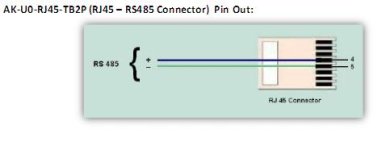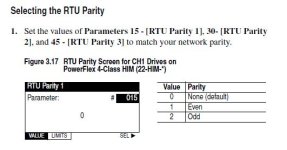Lemming,
We might be on to something here...
You are working off of firmware v1.xxx options for the 1769-SM2; manual 2006. As per your attachment, the RTU serial framing parameters are called [RTU Parity x], and you can only select options...
[RTU Parity x]
0 (8-N-1)
1 (8-E-1)
2 (8-O-1)
...all of which only allow 1 stop bit.
I am looking at the firmware v2.xxx options for the 1769-SM2, released since 2010. They made changes to the RTU serial framing parameters. They are now called [RTU Format x], which makes more sense as Parity is only one aspect of the framing. They added the options 3, 4 and 5 to set the parity for 2 stop bits for certain slaves that adhere to that standard.
[RTU Format x]
0 (8-N-1)
1 (8-E-1)
2 (8-O-1)
3 (8-N-2)
4 (8-E-2)
5 (8-O-2)
mxm_88,
It sounds like the 1769-SM2 firmware is at v1.xxx, which is why you cannot set option 3 (8-N-2). If you can confirm this, and if at v1.xxx, then you need to flash the module to v2.xxx to support the pCO Modbus slaves, which use 2 stop bits. You can do this via the CompactLogix across the backplane to the module.
The recommended [RTU Rx Delay x] when using a PowerFlex 4 drive at 19,200 baud is 2ms and 8ms for [RTU Tx Delay x]. The [RTU MsgTimeout x] is a default 2secs. You may need to increase this. As you will be using 19,200 baud to the slaves, I would start with these values and see how you go.
They have also made improvements to the modules tolerance to intercharacter delay for received packets, and corrected issues with the Modbus Master read/write commands. So either way it will serve you well to go to v2.xxx.
Here is the Release Notes for firmware v2.xxx. It can assist you in determining the current firmware version, and in how to flash the firmware to v2.xxx...
Publication 1769M2-RN001A-EN-E – June, 2010
This is the latest User Manual for the 1769-SM2, which includes the v2.xxx updates...
Publication 1769-UM013C-EN-P – June, 2010
(Supersedes 1769-UM013B-EN-P – January, 2006).
Regards,
George







